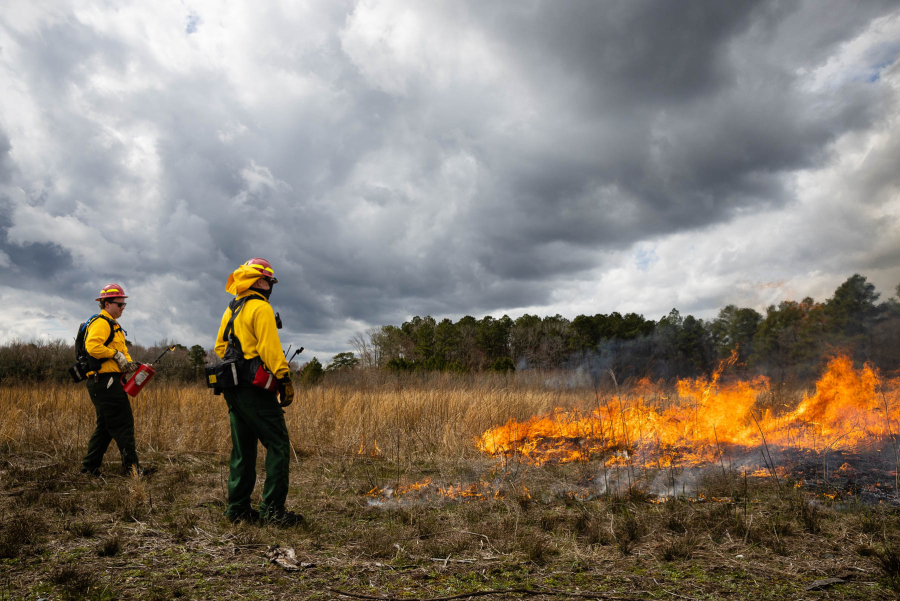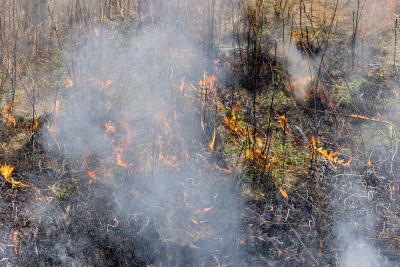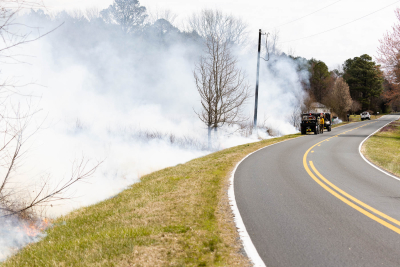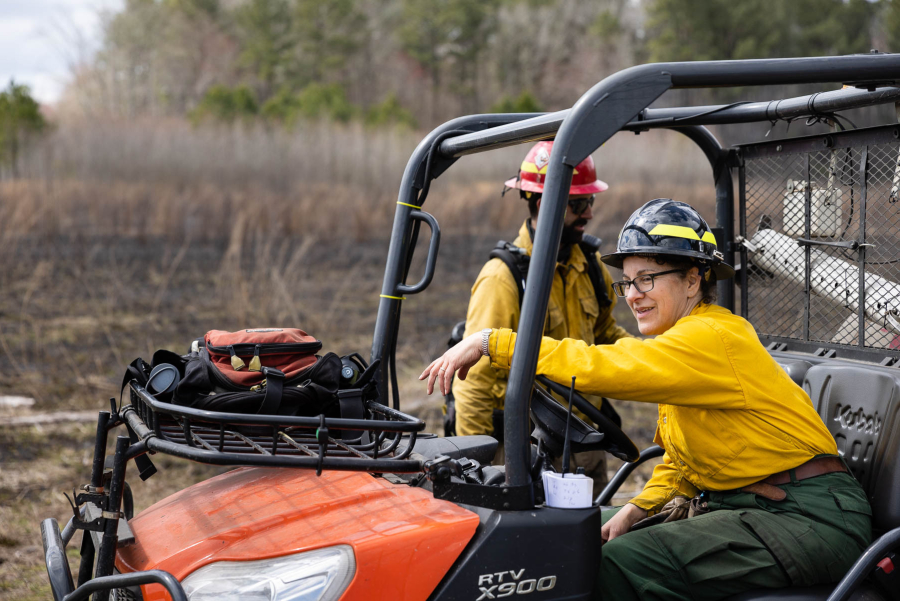A hot take on restoring habitat
Prescribed burns are supporting wildlife across the Chesapeake watershed

As fire spread through a 20-acre parcel of Nassawango Creek Preserve in Maryland’s Wicomico County one spring morning, managers from The Nature Conservancy (TNC) and other partners watched carefully. But they didn’t rush to stamp out the flames curling up from the tall grassland. In fact, the fire was their deliberate effort to restore a natural form of disturbance to the landscape and maintain a habitat that is in short supply.
“This is great habitat for ground-nesting birds,” said Deborah Landau, director of ecological management for TNC’s Maryland/D.C. chapter, before turning her gaze to the loblolly pines rising high at the edge of the grassland. “This is excellent quail habitat as well, because you’ve got that transition from high to low.”
In the past, lightning strikes would have naturally caused regular fires. Indigenous peoples eventually began using low-intensity fires intentionally to manage the land. However, beginning around the 1930s, roughly a century of fire suppression has left many forests in the United States with an even-age structure—a lot of similarly aged trees without areas of grassland mixed in, known as early successional habitat.
“That's absolutely not healthy,” Landau said. “So, one of the things we're doing is to try to get more of the diversity [of habitats].”

Prescribed burns are used across the Chesapeake Bay watershed, and not only to maintain grasslands. For example, thousands of acres of wetlands within Blackwater National Wildlife Refuge are subject to burns in order to help cycle nutrients back into plants that support the salt marsh. And some forest species like the pitch pine are well-adapted to fire, even depending on blazing heat to open up its pinecones and release seeds. A forest with a healthy mix of fire-tolerant and intolerant tree species is more resilient to the extended droughts that are one of the impacts of climate change.
“When those droughts do occur, stressors such as insect outbreaks or disease or drought are not going to negatively impact the landscape as much,” Landau said.
Landau, who received her Ph.D. in Entomology and Plant Biology from Louisiana State University, said TNC has observed a general increase in diversity following regular burns—such as an increase in insects that support more birds and bats. Populations of the red-headed woodpecker, a species that lives in open pine woods and that has been declining across the East Coast, have “skyrocketed” in response to prescribed burns.
“We've had plants reappear that have been gone for decades—such as pitcher plants, such as numerous rare orchids.” Landau said.
People stand to benefit from low-intensity fires along with wildlife. Fire has been shown to reduce dreaded tick populations in brushy areas that have been thinned out by burning. And Machicomoco State Park in Virginia is using fire along with interpretive signage that help visitors understand how indigenous peoples in the region used the management practice for many centuries.

As opposed to using heavy machinery, fire is also a relatively easy management technique to apply to a large swath of property, with the planning taking the most amount of time.
“If it's a 10-acre or a 1,000-acre burn, it's almost the same amount of effort—getting your crew out, getting the weather right, getting the [fire] lines prepped,” Landau said.
Fire also triggers a pulse of heat that encourages germination and a flush of nitrogen that supports plant growth. “So, it's a combination of processes that we just can't replicate by, say, just by cutting to let more light to the ground,” Landau said.
A typical burn, like the one at Nassawango Creek Preserve, is led by three bosses who maintain constant communication with their supporting crew members. An ignition boss coordinates the ignition, a holding boss makes sure the burn stays where it’s supposed to and a burn boss leads the overall operation. The team monitors any changes in temperature, humidity, wind speed and wind direction.
“And that gives them a really good sense for what to expect out of the fire behavior,” Landau said. “So, they're always on top of what's happening.”
Like many of TNC’s burns, the one at Nassawango Creek Preserve was a true partnership, with a crew including staff from Maryland Department of Natural Resources, the U.S. Forest Service and U.S. Fish & Wildlife Service.

Though not in use that day, a new piece of technology has made many burns easier. Landau and the team with TNC fly drones loaded with a fire-starting compound called potassium permanganate that is packed into small, stable spheres called dragon eggs. These payloads can be dropped right into the heart of a target area, saving humans the trouble of navigating thick vegetation on foot.
When a forest doesn’t burn for decades or centuries, the accumulating plant litter can fuel high-intensity fires that are truly destructive. But a fire like the one at Nassawango Creek Preserve, rather than a raging inferno, is more like a sauntering bonfire. The ground is left cool to the touch, preserving roots and seeds. And it leaves a mosaic of burned and unburned patches that allow wildlife to seek refuge during the temporary disruption.
The result is a landscape that is better able to regenerate as well as remain healthy and resilient. For Landau, there is no better tool when it comes to ecological restoration.
“I've absolutely found that using controlled fire is the most powerful tool we have,” Landau said. “By bringing fire back, we can achieve so much.”

Comments
There are no comments.
Thank you!
Your comment has been received. Before it can be published, the comment will be reviewed by our team to ensure it adheres with our rules of engagement.
Back to recent stories